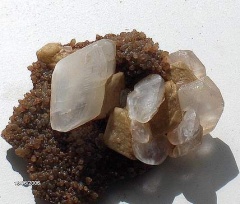Icelandic spar
| Infobox on Icelandic spar | |
|---|---|
| Example of Icelandic spar |  |
| Facts | |
| Origin | Originally mined in Iceland but currently also produced in for instance Mexico, United States and China |
| Stowage factor (in m3/t) | - |
| Humidity / moisture | - |
| Ventilation | - |
| Risk factors | - |
Icelandic spar
Description / Application
Icelandic spar
Iceland spar, formerly known as Iceland Crystal, is a transparent variety of calcite, or crystallized calcium carbonate, originally brought from Iceland, and used in demonstrating the polarization of light. It occurs in large readily cleavable crystals, easily divisible into rhombs, and is remarkable for its double refraction.
The name calcite comes from a Greek word meaning lime. This comes from its chemical component, Calcium Carbonate, which sometimes is mistakenly known as "lime." Calcite is known in more than 300 forms of crystals.
Super white quality of calcite in powder form (-300 mesh) is used in the manufacture of paint and distemper. It is also used in the manufacture of cement, Calcium Carbide, metal polish and sometimes also as a fluxing agent.
Calcite is a carbonate of lime (CaCo3). It crystallizes in rhombohedron class. It is also known by the name calc-spar. It is white in colour but is also found in various shades like pink, brown etc., depending upon the impurities present. It is identified easily from other lime minerals by its well defined rhombohdral cleavage and hardness 3 of Moh's scale. Its composition is identical to that of limestone but the latter occurs as sedimentary beds. There is another mineral, aragonite, of the same chemical composition. It crystallizes in orthorhombic system. It is, however, an unstable mineral, found mainly associated with gypsum beds and the tests of reef-building corals. It is not found in the same large quantity as that of calcite.
Modes of occurrence
Calcite is found in veins traversing various rock types, particularly limestone of the Aravalli and Ajabgarh series in Rajasthan, India. Calcite veins 30 to 150 cm. Thick, running uniformly sometimes for long distances, are usually found. Calcite also occurs as calcareous tufa, travertine, stalactite and stalagmite.
Mining
The mineral is worked by shallow pits. During mining the calcite is sorted out into different grades depending upon the colours as they fetch different prices and also, because their suitability depends upon the colours. The mineral is used invariably in the form of fine powder. Few important mine-owners have their own pulverizing plants; others sell to pulverizers. Generally calcite is supplied in three qualities:
- Best white (super-fix)
- White (Calico)
- Grey white (Gemco)
Industrial Applications
Calcite in pulverized form finds use mostly as filler in rubber and textile goods. A considerable quantity is also used in the ceramics industry for the preparation of glazes. Super white quality of calcite in powder form (-300 mesh) is used in the manufacture of paint and distemper. Calcite is now insecticides. It is also used in the manufacture of cement, calcium carbide, metal polish and sometimes also as a fluxing agent. The transparent and clear crystals are used in the optical industry, for the manufacture of nicol prism. Principal characteristics which make iceland-spar of special value for use in optical instruments are its very high birefringence, high degree of purity, perfect crystalline structure and transparency. The mineral must be in pieces at least 25 mm. long, 12 mm. thick, colourless, transparent and free from cloudy inclusions, cavities, and foreign substances.
Note:
Surface scratches preclude the use of this commodity (Icelandic spar) for optical use, but it may be used chemically as a very pure calcium carbonate.











